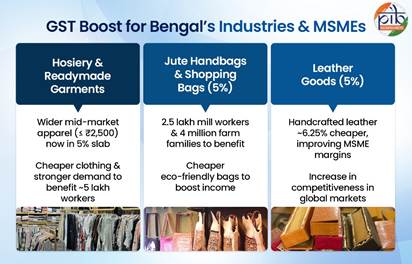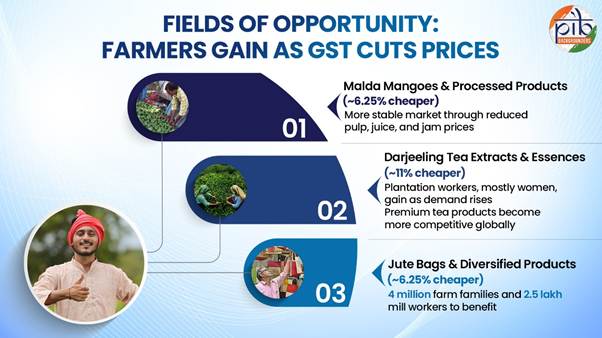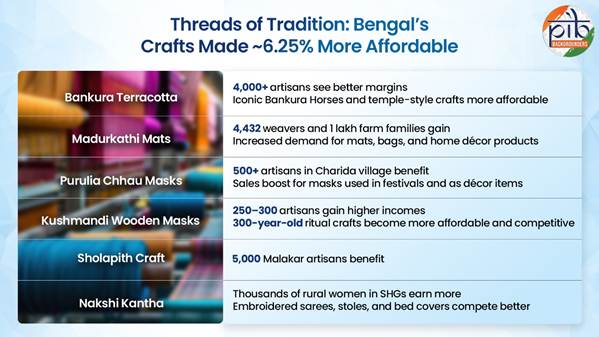Economy
From Terracotta to Textiles: GST Reforms to Empower Bengal’s Industries
Posted On:
04 OCT 2025 15:24 PM
Key Takeaways
- GST cut from 12% to 5% lowers prices by 6-11% across crafts, handlooms, jute, leather, garments
- Over 10 lakh livelihoods benefit; from 4,000 Bankura terracotta artisans to 5 lakh leather workers
- Garments up to ₹2,500 now taxed at 5%, benefitting 5 lakh hosiery jobs and boosting exports
- Specialty agro produces such as Malda mango and Darjeeling tea to gain with new 5% GST on processed food items
|
Introduction
West Bengal has long been known for traditional crafts, handlooms, and agro-based industries. From the terracotta temples of Bishnupur to the intricate embroidery of Nakshi Kantha, from the vibrant masks of Purulia to the globally admired Darjeeling tea, Bengal’s artisanal and industrial heritage sustains millions of livelihoods. The GST reforms reinforce Bengal’s identity as a hub of artistry and enterprise while ensuring that local communities can thrive in both domestic and international markets.
These changes will directly empower artisans, farmers, and small entrepreneurs of Bengal, making their products more competitive in both domestic and global markets. This will not only promote Bengal’s artisanal heritage but also strengthen local economies across districts.

Textile Industry & MSMEs
Nakshi Kantha
Nakshi Kantha, is one of Bengal’s most iconic embroidery traditions, practiced widely in rural districts such as Birbhum, Murshidabad, and Nadia. Rooted in the thrift of recycling old saris and dhotis into quilts, Kantha embroidery has evolved into a vibrant art form that provides both economic independence and creative expression for rural women. Today, it provides a crucial source of income for rural women, often working in self-help groups or family units.
The GST cut from 12% to 5% directly benefits this sector by reducing prices by around 6.25%. For example, an elaborate Kantha-stitched saree or shawl priced at ₹8,000 will now cost ₹500 less. This makes authentic, hand-embroidered Kantha more affordable in domestic markets and strengthens its competitiveness against machine-embroidered or mass-produced imitations.
In global markets, particularly Europe, the USA, and Japan, this traditional embroidery is appreciated for its intricate hand-stitching and unique aesthetic. It also holds a niche in the fair-trade and sustainable fashion markets within these regions. Improving affordability and margins will improve global competitiveness and expand its market reach.
Jute Handbags and Shopping Bags
 West Bengal lies at the heart of India’s jute industry, which provides direct employment to over 2.5 lakh workers in organized mills and supports about 40 lakh farming families.
West Bengal lies at the heart of India’s jute industry, which provides direct employment to over 2.5 lakh workers in organized mills and supports about 40 lakh farming families.
The industry's annual turnover exceeds ₹10,000 crore, with about 70% of production being traditional sacking bags procured by the government for food grain packaging. Further, there is an increased demand for diversified jute products (JDPs) like fashion bags and décor items.
The GST reduction from 12% to 5% is expected to lower retail prices by approximately 6.25%. For a bag priced at ₹1,000, consumers save over ₹60, making eco-friendly jute more competitive against plastic or synthetic alternatives. This boosts domestic demand in urban markets while also supporting exports, where JDPs already fetch significant value.
For artisans and workers in West Bengal, the tax relief improves profitability and market access, while also improving competitiveness. By targeting such value-added, consumer-facing products, the GST cut will reform the “Golden Fibre” identity relevant to modern lifestyles.
Hosiery and Ready-Made Garments
Hosiery and readymade garments, form one of West Bengal’s largest industries, employing an estimated 5,00,000 workers. Kolkata is the historical birthplace of India’s hosiery industry, with major clusters in Metiabruz, Baruipur, and Siliguri. The industry is characterized by a few large brands like Lux, Rupa, Dollar, that outsource production to thousands of small, unregistered units.
The increase in the threshold for the 5% GST slab to Rs. 2500 is the most impactful change. While the 5% rate remains unchanged, the revised threshold means that most mid-market apparel, including innerwear, kids’ wear, and T-shirts, now qualifies for the lower tax bracket.
This tax relief benefits both consumers and manufacturers. With increased affordability, consumer demand is expected to rise. Further, about 12% of West Bengal's handloom and textile products are exported. With the new rates, exports gain more competitiveness. By easing tax burdens, the reform supports a labour-intensive sector critical to Bengal’s economy and heritage.
Horticulture Products
Darjeeling Tea Extractions and Essences
Darjeeling tea, from the misty hills of Darjeeling and Kalimpong districts, is a world-famous luxury black tea, often dubbed the “Champagne of Teas”. Its unique muscatel flavor comes from specific agro-climatic conditions of the region, including high altitude, cool weather, and Chinese Camellia sinensis tea bushes. The industry has historically shaped the socio-economic fabric of the region, operating under a plantation model that employs lakhs of people, with women making up the majority of the workforce. These workers live on the estates, and tea cultivation forms the backbone of their livelihoods.
While GST on basic tea remains at 5%, tea extracts, essences, and concentrates have also been reduced from 18% to 5%. This is expected to lower costs by approximately 11%. As a result, value-added products like instant tea, ready-to-drink beverages, and extracts used in food and cosmetic industries will be significantly more affordable.
This tax cut also directly benefits the export-driven nature of Darjeeling tea, which was India's first product to receive the GI tag. An export-oriented product, it finds huge markets in countries such as Japan, Germany, the UK, and the USA, where processed tea products are increasingly in demand. By encouraging diversification into value-added segments, the reform reduces overreliance on traditional leaf tea sales and opens new revenue streams.
Overall, the GST reduction will strengthen the Darjeeling tea industry’s economic viability and ensure that this heritage product continues to thrive both in domestic niche markets and in the global premium beverage industry.
Malda Mango Processing Industry
Malda district, often called Bengal’s “Mango Capital”, produces over 200 varieties of mango. Its famed variants, Fazli, Laxman Bhog and Khirsapati (Himsagar), are GI-tagged, emblematic of the region’s identity. Mango cultivation is central to Malda’s economy as about 4.5 lakh people, including ~80,000 growers, are directly and indirectly associated with this industry.
On average, Malda produces around 3.5 lakh metric tonnes of mangoes annually, from which a growing portion is processed into pulp, juices, jams and pickles. Domestic and global demand for these products is strong, with mango exports from Malda reaching over ₹80 crore in 2023. The GI-tagged varieties are exported to the Middle East, UK, Europe, and recently to new markets like Sweden and New Zealand.

The GST reduction from 12% to 5% on processed mango products, juices and jams, will reduce their retail price by approximately 6.25%. This makes processed products more affordable for domestic consumers and encourages the food processing industry. With increase in demand and an assured market for their produce, farmers’ income will also become more stable.
Handicrafts
Bankura Panchmura Terracotta Craft
In Bankura district, especially Panchmura village and the Bishnupur region, the terracotta craft is a hereditary occupation of the regional communities. The famous Bankura Panchmura terracotta figures, notably the stylized Bankura Horse, originated under the patronage of the Malla kings of Bishnupur in the 17th century. Today, the craft is carried by 4,000+ artisans, mostly family-based enterprise, including women. Local markets and government fairs like the Hasta Shilpa Mela in Kolkata are key outlets.
The new GST cut from 12% to 5% is significant for the Bankura terracotta handicrafts, bringing about a 6.25% reduction in retail prices. For example, on a large decorative terracotta horse sold for ₹5,000, consumers save roughly ₹312 in tax. This amount of savings will stimulate demand and boost sales, improving livelihoods of the households engaged in this industry.
Madurkathi Mats & Diversified Products
In the districts of Purba and Paschim Medinipur, thousands of families weave Madurkathi mats and products. Sabang in Paschim Medinipur is the largest hub of this craft with women leading the weaving process. For many households, mat weaving is not just a tradition, as over 77% of craft persons rely on it as their main source of income. Around 1 lakh farm families are engaged in cultivating the mat-sedge and weaving, while 4,432 artisans across 11 blocks in Medinipur are officially registered as Madur weavers.
In Bengal’s humid climate, Madur mats are household staples, while value-added products like bags, table runners, folders, and coasters, have gained traction domestically and globally.
The GST cut from 12% to 5% will make Madurkathi mats and diversified products approximately 6.25% cheaper. This gives a meaningful boost to artisans’ incomes and expanding consumer demand.
Purulia Chhau Masks
The vibrant Chhau dance masks of Charida village in Purulia district are crafted by the local artisanal communities. Around 500 people from 310 families in Charida are directly engaged in this craft, with 85% of Charida’s artisans depending on it as their primary livelihood. The masks are central to the Purulia Chhau dance tradition and are also sold widely as decorative art, both domestically and internationally.
The recent GST rate reduction from 12% to 5% directly impacts the affordability and competitiveness of this craft. This brings a 6.25% fall in prices, which is significant in both cultural and commercial terms. For instance, on a mask priced at ₹4,000, buyers now save around ₹250. For dance troupes, this makes acquiring ornate masks more feasible. The lower costs also improve accessibility and demand for traditional handicraft items. In export markets, where these masks are showcased in exhibitions across the UK, USA, France, and Japan, the GST cut increases artisans’ margins and global competitiveness.
Thus, the tax relief not only protects a 150-year-old tradition but also secures livelihoods in Charida, strengthening both cultural preservation and rural incomes.
Wooden Masks of Kushmandi
The Wooden Masks of Kushmandi are a centuries-old craft centered in Dakshin Dinajpur’s Kushmandi block, particularly Mahisbathan village. Associated mainly with the regional communities, this art is intertwined with the Gomira dance, where artisans view the mask-making process as an act of devotion. About 250–300 artisans actively engage in making these wooden masks. The craft is a significant source of supplementary income and cultural identity for these families.
The GST rate cut from 12% to 5% brings tangible relief to this community. The reduction translates to about 6.25% lower prices, meaning a mask priced at ₹5,000 will save ₹312 in taxes. For the artisans, this makes direct sales at fairs and through online portals more profitable.
With increased margins and improved affordability, the GST reform strengthens the artisans’ ability to sustain their craft, ensuring that this 300-year-old wooden mask tradition remains both culturally vibrant and economically viable.
Sholapith Craft
Sholapith craft is one of Bengal’s most delicate and sacred art traditions, practiced by around 5,000 artisans across districts such as Bardhaman, Murshidabad, Birbhum, Nadia, Hooghly, Malda, and South 24 Parganas. Traditionally, Sholapith garlands were offered to deities and nobles. Today, it is integral to Bengal’s cultural rituals, mainly Durga Puja and weddings. Approximately 5,000 artisans in West Bengal are engaged in this craft, with craftsmen spending months on intricate pieces.
The GST reduction from 12% to 5% directly enhances the competitiveness of this labour-intensive craft. The revised rated reduces the cost by 6.25%, meaning a decorative piece priced at ₹2,500 is now about ₹156 cheaper. This cost relief is vital in a market where artisans depend largely on skilled labour. The price reduction makes these eco-friendly and traditional items more competitive against plastic or thermocol decorations.
In both domestic and export markets, the tax cut is expected to increase demand and improve profitability. By easing costs and widening reach, the reforms will help sustain a craft often called the "herbal ivory of Bengal".
Shantiniketan Leather Goods
The Shantiniketan leather goods cluster, centred in Birbhum district’s Santiniketan-Bolpur region and adjacent villages like Surul and Ballavpur, has long been famed for its hand-embossed batik and appliqué designs on tanned leather. Rooted in Visva-Bharati University’s rural development programs, the craft serves as a vital source of livelihood in areas with limited alternative employment. The industry is characterized by a distributed model of small MSMEs which provides direct employment to hundreds of artisans. The broader leather cluster in and around Kolkata provides employment to approximately 5 lakh people.
The domestic market for these goods is vibrant, with products sold through boutiques, emporia, and online GI-focused platforms such as GiTAGGED and GIHeritage. Annual turnovers for small enterprises range between ₹50 lakhs and ₹2.5 crore, highlighting the sector’s economic importance. Internationally, this leatherwork finds demand in Japan, the USA, and Europe, where buyers value their authenticity over mass-produced alternatives.
The GST rate cut from 12% to 5% provides a direct price reduction of approximately 6.25%. A handbag priced at ₹2,000, for example, now saves the consumer ₹125. For artisan-led MSMEs, this tax relief improves competitiveness against synthetic goods, increases margins, and allows for reinvestment in design, quality, and marketing. By reducing costs for consumers and raising profitability for producers, the reform strengthens rural livelihoods and helps preserve the unique identity of Shantiniketan leather craft in global markets.

Conclusion
West Bengal’s rich tapestry of traditional industries stands to benefit significantly from the new GST regime. With revised rates on goods from Shantiniketan leather to Malda mango products, the government aims to enhance affordability for consumers and improve margins for artisans. This will bring higher sales, job preservation and a boost to rural economies during the festive season and beyond.
More importantly, the changes provide a lifeline to rural households, encouraging the continuation of centuries-old traditions while aligning them with modern markets.
From Terracotta to Textiles: GST Reforms to Empower Bengal’s Industries
*****
SK/M
Visitor Counter : 61
Provide suggestions / comments
Read this explainer in :
Hindi